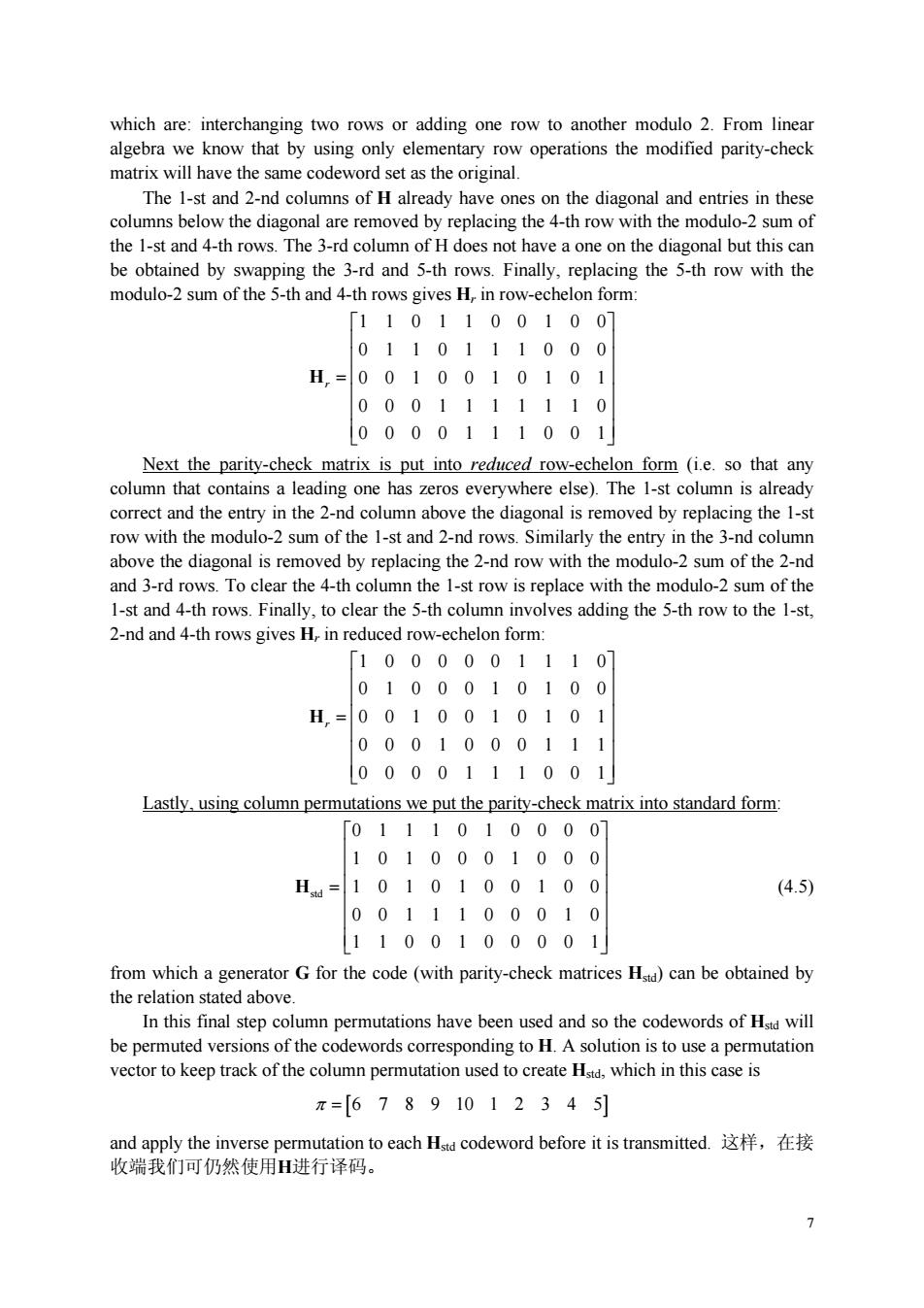正在加载图片...

which are:interchanging two rows or adding one row to another modulo 2.From linear operations the modified parity-check matrix will have the set as the original. The 1-st and 2-nd columns of H already have ones on the diagonal and entries in these columns below the diagonal are removed by replacing the 4-th row with the modulo-2 sum of the 1-st and 4-th rows.The 3-rd column of H does not have a one on the diagonal but this can be obtained by swapping the 3-rd and 5-th rows.Finally,replacing the 5-th row with the modulo-2 sum of the 5-th and 4-th rows gives H,in row-echelon fo 110.1100100 0110111000 H,=0010010101 0001111110 0000111001 Next the parity-check matrix is put into reduced row-echelon form (i.e.so that any column that contains a leading one has zeros everywhere else).The 1-st column is already correct and the entry in the 2-nd column above the diagonal is removed by replacing the 1-st ws.Similarly the er in the 3-nd column and 3-rd rows.To clear the 4-th column the 1-st row is replace with the modulo-2 sum of the 1-st and 4-th rows.Finally,to clear the 5-th column involves adding the 5-th row to the 1-st, 2-nd and 4-th rows gives H,in reduced row-echelon form: [1000001110 0100010100 H,=0010010101 0001000111 000011100 Lastly,using column permutations we put the parity-check matrix into standard form 011 1010000 1000 010 100100 (4.5) 01 1 1 00010 1100100001 from which a generator G for the code (with parity-check matrices H)can be obtained by the relation stated above. In this final step column permutations have been used and so the codewords of Hatd will π=[67891012345] and apply the inverse permutation to each Ha codeword before it is transmitted.这样,在接 收端我们可仍然使用H进行译码。7 which are: interchanging two rows or adding one row to another modulo 2. From linear algebra we know that by using only elementary row operations the modified parity-check matrix will have the same codeword set as the original. The 1-st and 2-nd columns of H already have ones on the diagonal and entries in these columns below the diagonal are removed by replacing the 4-th row with the modulo-2 sum of the 1-st and 4-th rows. The 3-rd column of H does not have a one on the diagonal but this can be obtained by swapping the 3-rd and 5-th rows. Finally, replacing the 5-th row with the modulo-2 sum of the 5-th and 4-th rows gives Hr in row-echelon form: 1101100100 0110111000 0010010101 0001111110 0000111001 r ⎡ ⎤ ⎢ ⎥ = ⎣ ⎦ H Next the parity-check matrix is put into reduced row-echelon form (i.e. so that any column that contains a leading one has zeros everywhere else). The 1-st column is already correct and the entry in the 2-nd column above the diagonal is removed by replacing the 1-st row with the modulo-2 sum of the 1-st and 2-nd rows. Similarly the entry in the 3-nd column above the diagonal is removed by replacing the 2-nd row with the modulo-2 sum of the 2-nd and 3-rd rows. To clear the 4-th column the 1-st row is replace with the modulo-2 sum of the 1-st and 4-th rows. Finally, to clear the 5-th column involves adding the 5-th row to the 1-st, 2-nd and 4-th rows gives Hr in reduced row-echelon form: 1000001110 0100010100 0010010101 0001000111 0000111001 r ⎡ ⎤ ⎢ ⎥ = ⎣ ⎦ H Lastly, using column permutations we put the parity-check matrix into standard form: std 0111010000 1010001000 1010100100 0011100010 1100100001 ⎡ ⎤ ⎢ ⎥ = ⎣ ⎦ H (4.5) from which a generator G for the code (with parity-check matrices Hstd) can be obtained by the relation stated above. In this final step column permutations have been used and so the codewords of Hstd will be permuted versions of the codewords corresponding to H. A solution is to use a permutation vector to keep track of the column permutation used to create Hstd, which in this case is π = [6 7 8 9 10 1 2 3 4 5] and apply the inverse permutation to each Hstd codeword before it is transmitted. 这样,在接 收端我们可仍然使用H进行译码